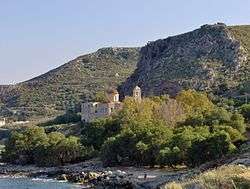Gonia Monastery

Gonia Monastery (Greek: Μονή Γωνιάς), Monastery of Our Lady of Gonia or Monastery of Panagia Hodegetria (Μονή της Οδηγήτριας) is an Orthodox monastery located 1 km north of Kolymvari and some 26 km from Chania, on the coast of the south-east Rodopos peninsula in Crete, Greece, overlooking the Gulf of Chania.[1]
History
Today dedicated to the Assumption of the Virgin (feast day: August 15), the monastery was founded in the 9th century and was originally dedicated to St. George.[2] It was originally situated at Menies on the ruins of the ancient temple of Artemis Britomartis (Diktynna).[2] The monastery was built in the 13th century adjacent to a cemetery, but it was rebuilt between 1618 and 1634 in its present location, with Venetian influences in its architectural design and adornment.[3] The distinctive fountain in front of the monastery's entrance was built in 1708 and the belfry in 1849.[3]
According to monks the present location at Kolymvari was considered a safer from attack.[2] Despite this, the monastery was heavily damaged by Ottoman bombardment on many occasions throughout its history including in 1645, 1652, 1822, 1841, and finally in 1867 during the Cretan Revolt (1866–1869) against the Ottoman Empire, evidence of which can be seen today by the remaining cannonball lodged in the monastery wall.[1][3] During World War II the monastery was partly destroyed by German bombing and it became one of the most important areas of Cretan resistance to Nazi Germany.[2]
Architecture and relics
Gonia Monastery is a Venetian-style fortress monastery. Its main church has a narthex, a dome, and a number of chapels surrounded by a courtyard.[1] The courtyard area is also where the quarters of the abbot and monks of the monastery are situated along with the refectory and storehouses.[1]
Today, the monastery contains numerous Byzantine artifacts from the 15th and 17th century including Cretan icons by Parthenios, Ritzos, and Neilos.[3] It also has numerous relics and other rare religious treasures from the Byzantine period and ancient inscriptions on the walls.[1]
References
- 1 2 3 4 5 "Gonia Monastery". Crete Tour Net. Retrieved May 10, 2009.
- 1 2 3 4 "Monastery of Gonia and the Orthodox Academy". Greekhotel.com. Retrieved May 10, 2009.
- 1 2 3 4 "Moni Goria". Rollins College. Archived from the original on July 29, 2009. Retrieved May 10, 2009.
Coordinates: 35°33′2″N 23°46′36″E / 35.55056°N 23.77667°E
| Wikimedia Commons has media related to Gonia Monastery. |